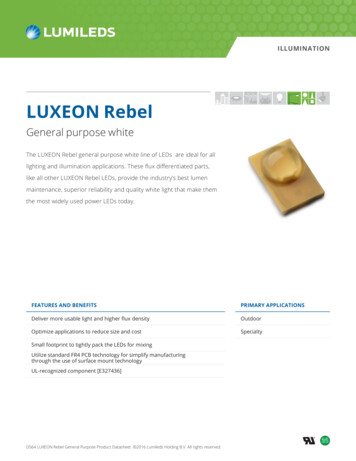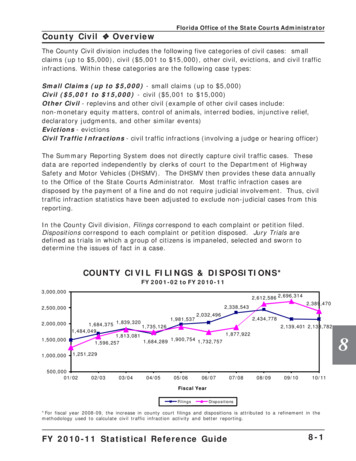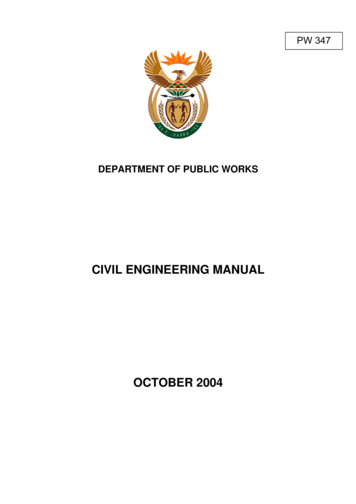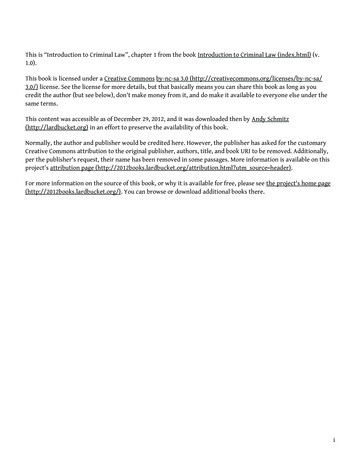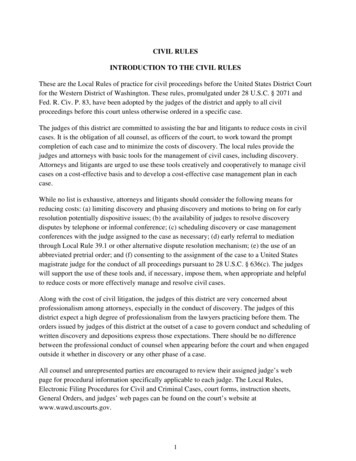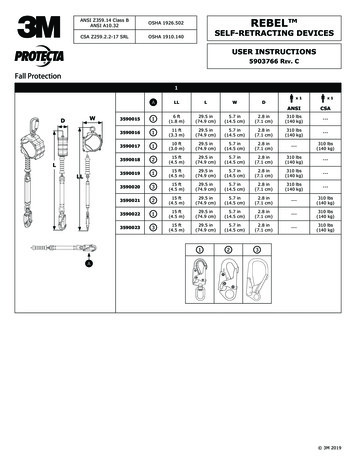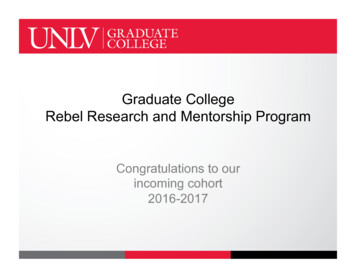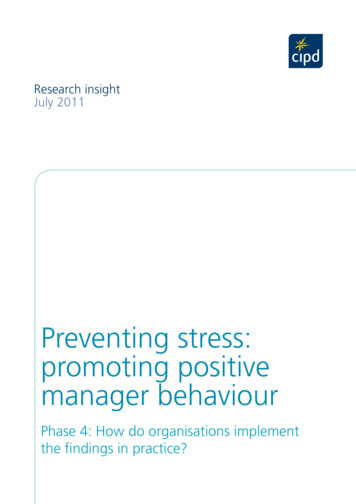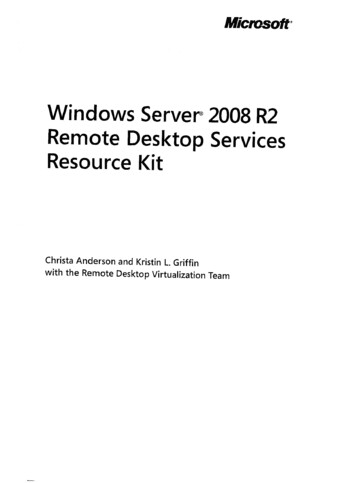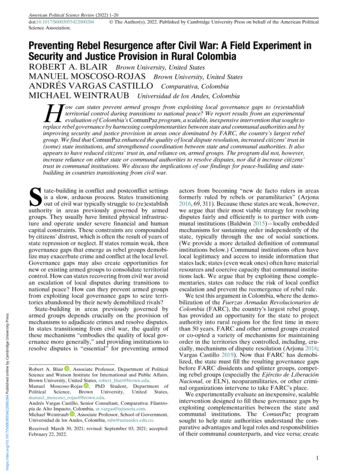
Transcription
American Political Science Review (2022) 1–20doi:10.1017/S0003055422000284Science Association. The Author(s), 2022. Published by Cambridge University Press on behalf of the American PoliticalPreventing Rebel Resurgence after Civil War: A Field Experiment inSecurity and Justice Provision in Rural ColombiaROBERT A. BLAIR Brown University, United StatesMANUEL MOSCOSO-ROJAS Brown University, United StatesANDRÉS VARGAS CASTILLO Comparativa, ColombiaMICHAEL WEINTRAUB Universidad de los Andes, ColombiaHow can states prevent armed groups from exploiting local governance gaps to (re)establishterritorial control during transitions to national peace? We report results from an experimentalevaluation of Colombia’s ComunPaz program, a scalable, inexpensive intervention that sought toreplace rebel governance by harnessing complementarities between state and communal authorities and byimproving security and justice provision in areas once dominated by FARC, the country’s largest rebelgroup. We find that ComunPaz enhanced the quality of local dispute resolution, increased citizens’ trust in(some) state institutions, and strengthened coordination between state and communal authorities. It alsoappears to have reduced citizens’ trust in, and reliance on, armed groups. The program did not, however,increase reliance on either state or communal authorities to resolve disputes, nor did it increase citizens’trust in communal institutions. We discuss the implications of our findings for peace-building and statebuilding in countries transitioning from civil war.https://doi.org/10.1017/S0003055422000284 Published online by Cambridge University PressState-building in conflict and postconflict settingsis a slow, arduous process. States transitioningout of civil war typically struggle to (re)establishauthority in areas previously governed by armedgroups. They usually have limited physical infrastructure and operate under severe financial and humancapital constraints. These constraints are compoundedby citizens’ distrust, which is often the result of years ofstate repression or neglect. If states remain weak, thengovernance gaps that emerge as rebel groups demobilize may exacerbate crime and conflict at the local level.Governance gaps may also create opportunities fornew or existing armed groups to consolidate territorialcontrol. How can states recovering from civil war avoidan escalation of local disputes during transitions tonational peace? How can they prevent armed groupsfrom exploiting local governance gaps to seize territories abandoned by their newly demobilized rivals?State-building in areas previously governed byarmed groups depends crucially on the provision ofmechanisms to adjudicate crimes and resolve disputes.In states transitioning from civil war, the quality ofthese mechanisms “embodies the quality of local governance more generally,” and providing institutions toresolve disputes is “essential” for preventing armedRobert A. Blair , Associate Professor, Department of PoliticalScience and Watson Institute for International and Public Affairs,Brown University, United States, robert blair@brown.edu.Manuel Moscoso-Rojas , PhD Student, Department nuel moscoso rojas@brown.edu.Andrés Vargas Castillo, Senior Consultant, Comparativa: Filantropía de Alto Impacto, Colombia, ar.vargas@tutanota.com.Michael Weintraub , Associate Professor, School of Government,Universidad de los Andes, Colombia, mlw@uniandes.edu.co.Received: March 30, 2021; revised: September 03, 2021; accepted:February 22, 2022.actors from becoming “new de facto rulers in areasformerly ruled by rebels or paramilitaries” (Arjona2016, 69, 311). Because these states are weak, however,we argue that their most viable strategy for resolvingdisputes fairly and efficiently is to partner with communal institutions (Baldwin 2015)—locally embeddedmechanisms for sustaining order independently of thestate, typically through the use of social sanctions.(We provide a more detailed definition of communalinstitutions below.) Communal institutions often havelocal legitimacy and access to inside information thatstates lack; states (even weak ones) often have materialresources and coercive capacity that communal institutions lack. We argue that by exploiting these complementaries, states can reduce the risk of local conflictescalation and prevent the reemergence of rebel rule.We test this argument in Colombia, where the demobilization of the Fuerzas Armadas Revolucionarios deColombia (FARC), the country’s largest rebel group,has provided an opportunity for the state to projectauthority into rural regions for the first time in morethan 50 years. FARC and other armed groups createdor co-opted a variety of mechanisms for maintainingorder in the territories they controlled, including, crucially, mechanisms of dispute resolution (Arjona 2016;Vargas Castillo 2019). Now that FARC has demobilized, the state must fill the resulting governance gapsbefore FARC dissidents and splinter groups, competing rebel groups (especially the Ejército de LiberaciónNacional, or ELN), neoparamilitaries, or other criminal organizations intervene to take FARC’s place.We experimentally evaluate an inexpensive, scalableintervention designed to fill these governance gaps byexploiting complementarities between the state andcommunal institutions. The ComunPaz programsought to help state authorities understand the comparative advantages and legal roles and responsibilitiesof their communal counterparts, and vice versa; create1
https://doi.org/10.1017/S0003055422000284 Published online by Cambridge University PressRobert A. Blair et al.opportunities for these authorities to build trust witheach other, and with citizens; and develop strategies toincrease communication and coordination betweencommunal institutions and the state. The programfocused on police officers, Police Inspectors, and Juntasde Acción Communal (JACs)—communal institutionsthat are critical to local governance in rural Colombia(Kaplan 2017; Vargas Castillo 2019). FARC and otherarmed groups tried and in many cases succeeded in coopting JACs to facilitate governance of the communities under their control; most previously co-opted JACscontinue to function even in communities abandonedby FARC, but without the coercive capacity thatFARC once provided. We argue that states can projectpower more successfully by mimicking this strategy,leveraging relationships with communal institutions topenetrate territories that lie within their de jure bordersbut beyond their de facto control. ComunPaz sought topursue precisely this approach to state-building.Our sample consists of 149 communities across fourrural regions of Colombia where FARC was historically dominant; roughly 81% of residents in our samplereport that armed groups controlled their communitiesat some point in the past. In total, 72 communities wererandomly assigned to participate in ComunPaz, whichwas administered in four modules over the course ofthree months in each treatment community. We evaluate the impact of the program using surveys of residents, JAC leaders, police officers, and PoliceInspectors. Unusually for an evaluation of this sort,our survey sample thus includes both the “supply”and “demand” sides of security and justice provision.The residents survey also includes endorsement and listexperiments designed to measure support for, andreliance on, armed groups—a potentially sensitivetopic. We combine the surveys with costly behavioralmeasures designed to operationalize residents’ willingness to petition for closer coordination between stateand communal authorities and JAC leaders’ willingnessto act on these petitions. We corroborate and contextualize our quantitative results using detailed qualitative field reports from ComunPaz facilitators.Consistent with our theoretical framework and preanalysis plan (PAP),1 we find that ComunPaz reducedthe prevalence of unresolved and violent disputes at thecommunity level as reported by survey respondents.We also find more suggestive evidence that the program diminished both perceptions of and reliance onarmed groups among residents. Importantly, we findthat reliance on armed groups was already rare in thesecommunities, and perceptions of them already unfavorable. While FARC had largely demobilized by thetime of our study, multiple additional armed groupswere already competing to supplant FARC’s rule.ComunPaz appears to have driven perceptions of andreliance on these other armed groups nearly to zero,potential floor effects notwithstanding. The program1Our PAP was preregistered with the Evidence and Governance andPolitics network prior to endline data collection, and is available athttps://osf.io/yw7ts/.2also improved perceptions of some state authorities,especially those that have frequent and direct contactwith their communal counterparts.Also consistent with our theoretical framework, wefind that the program increased coordination betweenthe state and communal institutions and improved thecohesiveness and functionality of communal institutions themselves. This is especially striking given thatour endline was administered approximately sevenmonths after the end of the intervention. Interestingly,and contrary to our expectations, the program appearsto have weakened demand for additional coordinationbetween state and communal authorities as captured byour costly behavioral measures. We interpret this asevidence that the program helped satisfy existingdemand for coordination, as reflected in the largenumber of petitions filed in all communities regardlessof treatment status. If ComunPaz helped satisfy existing demand for state–communal coordination, then it isperhaps unsurprising that we find lower demand intreatment communities after the program concluded.More surprisingly, we find no evidence that ComunPaz improved perceptions of communal institutions orincreased understanding of their roles and responsibilities under Colombian law. Nor do we find evidencethat the program strengthened state or communalauthorities’ awareness of the most serious disputes intheir communities or that it fostered consensus aroundhow disputes should be resolved. We also find noevidence that the program increased reliance on eitherstate or communal authorities to resolve disputes. Thisis puzzling given the reduced prevalence of unresolvedand violent disputes in treatment communities. In thediscussion we combine our quantitative and qualitativedata to explore several potential explanations for thissurprising combination of results.Taken together, our results suggest that states canprevent a resurgence of local violence, improve theirrelations with civilians, and impede the restoration ofarmed group control by exploiting complementaritieswith communal institutions—a strategy that armedgroups themselves often use to reinforce their local governance capabilities in the territories they control. Patterns of contestation and control during civil war oftenreshape local institutional configurations in profound andlasting ways, which may in turn affect the prospects forpeace. To date, however, few (if any) studies have testedwhether or how governments can engage these alteredinstitutional arrangements to promote stability and stateconsolidation. Our results demonstrate that states canexploit complementarities with communal institutions toextend their authority into areas where they were previously absent. More speculatively, given the ties betweenJACs and FARC in many Colombian communities, ourresults suggest that states recovering from conflict may beable to leverage the legacies of rebel governance in thepast to prevent renewed rebel control in the future.Our study contributes to multiple bodies of research.First, we contribute to the literature on rebel governance by exploring mechanisms for preventing armedgroups from filling local governance gaps during transitions to national peace (Arjona 2016; Arjona, Kasfir,
Preventing Rebel Resurgence after Civil War: A Field Experiment in Security and Justice Provision in Rural Colombiaand Mampilly 2015; Cunningham and Loyle 2021;Huang 2017; Mampilly 2011; Revkin and Ahram2020; Stewart 2018; Steele and Weintraub 2021). Second, we contribute to research on the relationshipbetween state and communal institutions by exploringways to leverage their underused complementarities(Baldwin 2015; Blair 2019; Bodea and LeBas 2016;Van der Windt et al. 2019). Third, we contribute tostudies of security and justice provision in postconflictcountries—most of which focus on strengthening thestate while excluding communal institutions, or viceversa (Blair, Karim, and Morse 2019; Blattman, Hartman, and Blair 2014; Hartman, Blair, and Blattman2021)—by testing mechanisms to empower the stateand its communal counterparts simultaneously. Finally,we contribute to the broader literature on peace-building and state-building by showing how states can benefit from cooperation with communal institutions thatare often marginalized during state-building processes(Call and Wyeth 2008; Isser 2011; Paris and Sisk 2009).THEORETICAL FRAMEWORKhttps://doi.org/10.1017/S0003055422000284 Published online by Cambridge University PressComplementarities between States andCommunal InstitutionsOne of the most basic functions of any government is toestablish institutions for adjudicating crimes and resolving disputes. These institutions preserve order (Levi1989), protect property rights (Blattman, Hartman, andBlair 2014), reduce transaction costs associated witheconomic exchange (North 1990), and more generallyallow individuals to “live together peacefully andengage in mutually beneficial cooperation” (Arjona2016, 70). Dispute-resolution institutions are especiallyimportant in countries suffering or recovering from civilwar. Where these institutions are effective and legitimate, they increase citizens’ loyalty to the state,strengthen their incentives to resist rebel encroachment, and improve their capacity to mobilize againstrebel rule (Kaplan 2017). As Arjona (2016, 11, 72)explains, resistance to rebel incursions is a function ofthe “quality of the local institutions in place prior to thearrival of the group, in particular, dispute institutions,”because these institutions deprive armed actors of “oneof the most effective means to consolidate their power:creating new dispute institutions and becoming the defacto administrators of justice for local populations.”But weak and war-torn states often fail to provideeffective, legitimate institutions for resolving disputes,and armed groups have succeeded in becoming local“administrators of justice” in a wide variety of settingsincluding Afghanistan, Sri Lanka, Ethiopia, Nepal,Cuba, Peru, and Sudan, among others. When thesegroups disarm, they leave behind governance gaps thatstates must fill in order to facilitate the implementationof peace agreements, prevent local conflicts from escalating into regional or national crises (Autesserre 2010;Blair, Blattman, and Hartman 2017), and impede otherarmed actors from seizing newly abandoned territories(García-Villegas and Espinosa 2015). But filling thesegaps is not easy. The same factors that facilitate insurgency also tend to impede the projection of state powerafter insurgents demobilize. For example, state infrastructure may be dilapidated and state bureaucraciesmay be dysfunctional, especially in rural areas. Communities that are accustomed to autonomy may alsoresist the (re)imposition of state rule.We argue that states can overcome these challengesby leveraging underused complementarities with communal institutions and authorities. Communal institutions provide public goods and resolve disputes at thelocal level while retaining some degree of independence from the state. They tend to be deeply embeddedin the communities they govern and typically rely onsocial sanctions rather than physical coercion toenforce their decisions (Bowles and Gintis 2002). Crucially, communal authorities are not mere extensions ofthe state. They are distinct from local police officers,judges, or magistrates, who may also provide publicgoods and resolve disputes, but who are employed bythe state and answerable to higher level officials withinthe state apparatus. Communal institutions are alsodistinct from the multitude of civil society groups andorganizations that may exist at the local level but thatdo not attempt to govern the communities in which theyare based (for example, youth groups or sports leagues).Some communal authorities operate independentlyof the state but are nonetheless recognized under statelaw, with constitutionally delineated roles and jurisdictions—for example, lineage chiefs in Mozambique(Lubkemann, Kyed, and Garvey 2011) or sheikhs practicing tribal customary law in Iraq (Asfura-Heim 2011).Others—secret societies in Liberia, for example (Blair,Karim, and Morse 2019)—are not recognized by thestate. Some derive power from their association withspecific historical customs, rituals, or lineages, as is thecase with elders and liurai in East Timor (Brown andGusmao 2009); others were elevated by state or colonial rulers but subsequently became powerful in theirown right, as is the case with Paramount Chiefs in SierraLeone (Acemoglu, Reed, and Robinson 2014).(We consider the generalizability of our results todifferent types of communal institutions in the conclusion.) Theoretically, the relationship between state andcommunal authorities is not inherently antagonistic,though confusion and contestation over jurisdictionalboundaries is very common in practice (Isser 2011).Communal institutions exist in most (if not all) societies. They tend to be locally legitimate and informedabout the most important sources of disputes amongcitizens. During periods of civil war, when the state isweak and threats to security are imminent, communalinstitutions may help preserve a semblance of localstability in the midst of national upheaval (Isser2011). During transitions to peace, they can facilitateaccess to rural communities and relieve the burden onthe state by adjudicating nonviolent crimes and pettydomestic conflicts, which might otherwise overwhelmthe justice system. If states could leverage these comparative advantages, they could extend their authoritywithout incurring the prohibitive costs of developing3
https://doi.org/10.1017/S0003055422000284 Published online by Cambridge University PressRobert A. Blair et al.the infrastructure and bureaucracy necessary to serveremote, sparsely populated areas (Baldwin 2015).Of course, communal institutions often suffer frompathologies of their own. During civil war they may beco-opted by armed groups to facilitate rebel governance. In Mozambique, for example, the ResistênciaNacional Moçambicana (RENAMO) relied on traditional chiefs known as régulos to resolve disputes,organize the provision of food and other supplies toRENAMO fighters, and ensure civilians’ adherence toRENAMO’s decrees. Similarly, the Sudan People’sLiberation Movement (SPLM) exploited customaryleaders to maintain order and enforce compliance withSPLM dictates (Arjona 2016).Although communal institutions may not need thirdparties to function, their reliance on social sanctionsrather than physical coercion makes them more susceptible to shirking, free-riding, and forum shopping(Blattman, Hartman, and Blair 2014). After armedgroups demobilize, the communal institutions they coopted may continue to function, but without the benefitof the coercive capacity that armed groups once provided, which may render their decisions unenforceable.Communal authorities may also be corrupt, biased, orineffective or may resolve disputes in ways that contravene state laws and due process protections (Blair 2019;2020).We argue that peace processes create windows ofopportunity for states to resolve these pathologies andfoster symbiotic relationships with communal authorities. During these transitional moments, states havestrong incentives to project their authority into previously rebellious territories, especially as the barriers tostate penetration erected by formerly dominant rebelgroups begin to fall. Transitions from civil war are alsoconducive to institutional innovations that may bemore difficult to achieve once peace is consolidatedand path dependence sets in (Call 2007). Communalinstitutions can in many cases provide the local legitimacy and inside information that states lack, helping toidentify conflicts before they escalate and bringingdisputants to the bargaining table. States can providethe coercive capacity that communal institutions oftenlack, ensuring that their decisions are enforceable andconsistent with legal rules and procedures. By exploiting these complementarities, we argue that states canproject power and increase their legitimacy, improvethe quality of dispute resolution at the local level, andprevent new or existing armed groups from gaining afoothold in communities recently abandoned by demobilized rebels.may be unaware of the legally circumscribed division oflabor between states and communal institutions. Inmany developing countries, communal authorities routinely (if inadvertently) exceed the legal limits of theirpowers, thus undermining the state’s jurisdictionalclaims (Blair 2019; 2020). For their part, state authorities often do not know the most important sources ofdisputes at the local level, thus limiting their ability torespond to citizens’ complaints.Second, in countries recovering from civil war, citizens and communal authorities may distrust state institutions and may (rightly) fear that wartime patterns ofstate predation or neglect will persist. Conversely, inareas previously controlled by armed groups, stateauthorities may (accurately) perceive their communalcounterparts as accessories to rebel rule. Third andrelated, state and communal systems of dispute resolution may develop in isolation, with few mechanisms tocoordinate their activities. Coordination problems mayarise even when state and communal authorities understand and trust one another, and even when theirinterests are aligned. Coordination problems may alsoafflict citizens: even citizens who agree on the legaldivision of labor between the state and its communalcounterparts may disagree about how, exactly, theyshould seek redress for a given grievance. Moreover,the inclusiveness and consensus inherent to much locallevel decision making may leave communal institutionsespecially vulnerable to shirking, free-riding, and dissension within their ranks.These three obstacles reinforce a suboptimal equilibrium in which states and communal institutionsoperate independently of, or in conflict with, oneanother. These dynamics are common in weak andwar-torn states. In Mozambique, “widely divergentinterpretations” of statutes delineating the division oflabor between state and communal authorities fomentjurisdictional competition and undermine dispute resolution (Lubkemann, Kyed, and Garvey 2011, 41). InGuatemala, distrust of the state underlies citizens’ continued reliance on local civil patrols to provide securityand justice, often through vigilantism (Bateson 2013).In Iraq, “vague provisions” in the law allow for coordination between state and communal authorities, butmechanisms for facilitating coordination are weak ornonexistent (Asfura-Heim 2011, 270). The interventionwe evaluate seeks to help state and communal authorities resolve precisely these problems in Colombia.Three Obstacles to Leveraging theComplementaritiesColombia is the site of the world’s longest civil war. In2016, after more than half a century of conflict, thegovernment signed a peace agreement with FARC, thecountry’s largest rebel group. But as with previousrebel and paramilitary demobilizations in the mid1980s and early 2000s, the transition to peace has beentumultuous, with multiple armed groups vying to fillgovernance gaps left in FARC’s wake. The Colombiangovernment is currently pursuing multiple strategies toconsolidate state authority, prevent local conflictExploiting the complementarities between states andcommunal institutions requires overcoming at leastthree obstacles that often arise in conflict and postconflict settings: a lack of (1) information, (2) trust, and(3) coordination. First, state authorities may beunaware of the legal roles and responsibilities of theircommunal counterparts, and vice versa. Citizens, too,4SETTING AND INTERVENTION
https://doi.org/10.1017/S0003055422000284 Published online by Cambridge University PressPreventing Rebel Resurgence after Civil War: A Field Experiment in Security and Justice Provision in Rural Colombiaescalation, and impede the establishment of new formsof rebel governance in communities previously controlled by FARC.The intervention we evaluate focuses on three actorsin particular: police officers, Police Inspectors, andJuntas de Acción Comunal (Community Action Councils, or JACs). Police officers are responsible for investigating serious crimes; Police Inspectors are mandatedto adjudicate petty crimes and coordinate with thepolice when serious crimes occur. Police Inspectorsare trained in conflict resolution by the central government’s Ministry of Justice and Law and are paid by theirrespective municipal governments, but they are notmembers of the police force per se. Their roles andresponsibilities were defined in Law 23 of 1991, whichsought to reduce congestion in the civil and criminaljustice systems by assigning tasks that might otherwisebe undertaken by the police to Police Inspectors.Colombian law defines JACs as “non-profit civicassociations, made up of neighbors of a given place,who bring together their efforts and resources toaddress the most important needs of the community”(Decree 1930 of 1978, art. 1). The Colombian government authorized the formation of JACs in 1958 following a brutal period of civil conflict known as LaViolencia. The goal was to foster reconciliation andcreate a “formal interlocutor between citizens and thestate” (Arjona 2016, 231). Although the governmentactively promoted JACs in some areas, in most communities they organized on their own, and in manycases communal institutions with similar functionsoperated for years before formally constituting themselves as JACs (Vargas Castillo 2019). Although JACsare sometimes conceptualized as a local level of government, they “clearly fall in the realm of local civilsociety,” and historically were “largely left to their owndevices” by the state (Kaplan 2017, 14, 80).Today JACs provide local public goods and resolvelocal disputes without guidance or interference by thegovernment, typically through a Coexistence and Conciliation Commission (Comisión de Convivencia y Conciliación), the unit within JACs that is responsible for(most) conflict resolution. In most cases they are inclusive, with one representative per household in eachcommunity (Vargas Castillo 2019, 83). They tend toenjoy high local legitimacy, are accessible and affordable, and have a presence in almost all rural areas,constituting the “most common form of ruralorganization” in the country (Kaplan 2017, 14). Butthey receive little if any training; have limited materialresources; and are often unfamiliar with the duties,powers, and constraints imposed on them by Colombian law. They also lack the coercive capacity toenforce potentially unpopular decisions.During the civil war, JACs developed varied andcomplex relationships with armed groups (Cubides2006). In some communities they helped civilians protect themselves from armed group violence (Kaplan2017); in others they were dismantled by encroachinginsurgents (Arjona 2016). Armed groups sought to coopt JACs during the conflict (Jaramillo, Mora, andCubides 1986), and in some cases JACs developedsymbiotic relationships with armed groups (VargasCastillo 2019). This was especially true in communitiescontrolled by FARC—the focus of our study. FARCgenerally operated as a “co-facilitator of organizationalprocesses” at the community level, using its coercivecapacity to support existing communal institutions(Jaramillo, Mora, and Cubides 1986, 175). FARC oftendemanded that all households enroll in JACs, enforcedattendance at JAC meetings, and ensured participationin collective labor days convened by JAC leaders.FARC benefited from the presence of locally legitimate institutions capable of resolving disputes andpreserving order independently of the state, whileJACs benefited from FARC’s coercive capacity, whichmade their decisions easier to enforce.Relations between police officers, Police Inspectors,and JACs are beset by the three obstacles of information, trust, and coordination discussed above. As part ofour endline survey, we asked JAC leaders seven simplefactual questions about the extent and limits of theirauthority under Colombian law. The modal JAC leaderin the control group answered fewer than half of thesequestions correctly. Fewer than one-third of controlgroup residents expressed trust in Police Inspectors atendline; perceptions were more positive among JACleaders but were still unfavorable. Police Inspectorsand JACs have few mechanisms for coordinating theirefforts. Only 12.5% of control group JAC leaders evenknew how to contact a Police Inspector at endline, andjust 17% reported that Police Inspectors “activelysupport” the JAC’s work. These information, trust,and coordination deficits limit the state’s ability toexploit complementarities with JACs in order to project power into areas susceptible to future armed groupcontrol.The ComunPaz ProgramWe evaluate an inexpensive, scalable interventiondesigned to induce closer coordination between policeofficers, Police Inspectors, and JACs, while avoidingthe pitfalls of forcibly imposing state laws and institutions on communities long accustomed to autonomy orrebel rule. The program and our evaluation of itoccurred at a pivotal transitional moment:
Published by Cambridge University Press on behalf of the American Political Science Association. Preventing Rebel Resurgence after Civil War: A Field Experiment in Security and Justice Provision in Rural Colombia ROBERT A. BLAIR Brown University, United States MANUEL MOSCOSO-ROJAS Brown University, United States ANDRÉS VARGAS CASTILLO .
